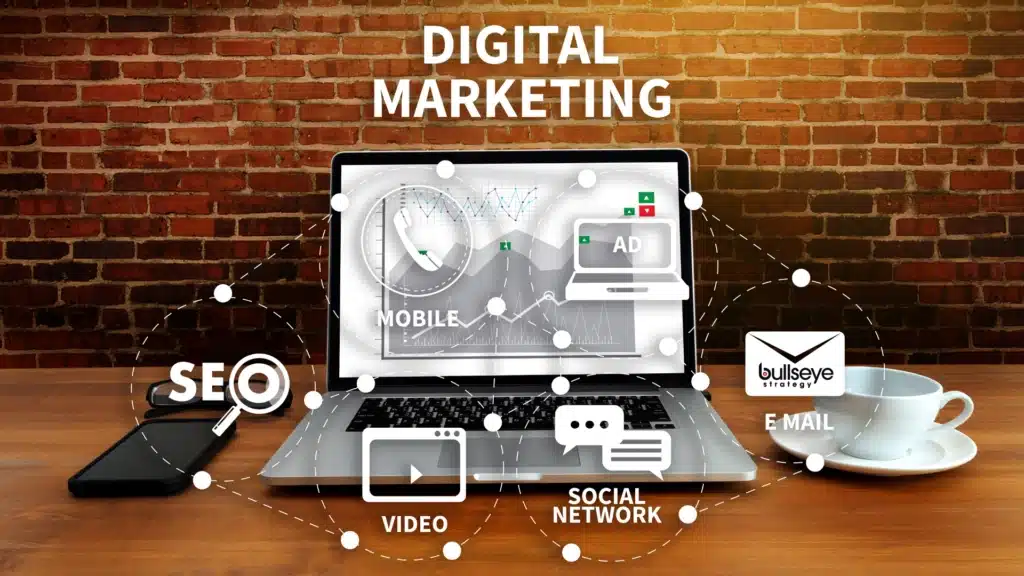The past year has been rampant with changes, some positive and several negatives. Though most of us anticipated shifts in how we would conduct business, no one predicted the magnitude of changes to the digital marketing landscape. At its core, digital marketing connects with the innate needs of a consumer. So, how can we still forge profitable connections when a consumer’s needs change?
The truth is, whether you’re part of a major conglomerate or operate a small business, your digital marketing efforts are overdue for an update. As the landscape continues to evolve in response to the recent pandemic, the needs of today’s consumers will adjust accordingly—and your standard digital marketing solutions cannot be leveraged in place of an effective strategy that matches these needs.
Don’t be fooled by an internet marketing solution that promises to increase revenue without human effort. Instead, learn how digital marketing solutions have changed in recent months and how your strategy must shift in response. Then, leverage the solutions you have in-house or contact a knowledgeable digital marketing agency to adjust to changes in 2021 and beyond.
The Evolving Landscape of Digital Marketing Solutions
Most digital marketing solutions are meant to take the guesswork out of effective brand awareness, lead generation, and conversion rate. However, if there’s one thing we know for sure about marketing, it’s that we can never guess how much the landscape will evolve. For instance, the marketing tools we used just a decade ago would be considered archaic today.
Software built for the 2010s lacks key features that relate to how we use the internet today. There are more than double the amount of internet users today than there were ten years ago. The number of Facebook users alone has jumped from 500 million to 2.8 billion since 2010. The digital marketing solutions of yesterday cannot keep up with the future of digital marketing.
The same goes for current digital marketing solutions that have not been acclimated to 2021.
The ramifications of the COVID-19 pandemic have permanently shifted the way millions operate. Many organizations have shuttered physical storefronts to sell online solely. Consumer spending has waned amid economic and health-related uncertainty. Privacy updates have drastically limited data collection. Now more than ever, we must adjust our marketing tools and strategy.
What Roadblocks Are You Facing?
The chances are pretty high that you landed on this blog because you’re currently facing a problem or roadblock you can’t solve alone. So, before we dive too deep into the digital solutions in your marketing campaign, let’s get to the bottom of the problem at hand. We’ve mentioned just how much the landscape is changing—what has it changed in your business?
Perhaps an influx of digital marketing from competitors has diminished your online presence. The pandemic encouraged a digital shift where brick and mortar businesses were forced to move online, saturating eCommerce and banner ads. On the other hand, maybe you’ve been dealing with extreme fluctuations in sales and data due to unforeseen environmental factors, like quarantine.
Across the board, privacy updates have upended digital marketing solutions. For example, users can now opt-out of in-app data collection on the Facebook or Instagram social media platforms, derailing ad retargeting or accurate measurement efforts. In addition, new cookie-less tracking and Mail Privacy Protection updates for Apple users mean your usual marketing channels may not yield consistent results.
The changes affecting digital marketing solutions have created new problems for businesses that must be addressed. As you continue to read the following steps for acclimating to recent changes, consider what’s currently plaguing your online marketing. Then, take a look at how to adjust your marketing strategy and choose the best digital solutions to overcome the roadblock.

Digital Marketing Strategy: Making Adjustments
If the events of the past 18 months have you confused about which direction to take your marketing strategy, trust that you’re not alone. At Bullseye Strategy, many of our clients have come to our marketing team with the same concern. There might be tons of ideas on the table but not enough actual work done—or worse, too much work for your in-house team to handle.
Realistically, problems arise when you have various avenues in front of you, and you aren’t sure which will be the most beneficial. For example, should your team focus on organic content and search engine optimization (SEO) or go a different route with Facebook ads and social media marketing? The best option is to build a strategy centered on your unique business goals and desired ROI.
A successful marketing strategy starts with a set of clearly defined goals, along with an understanding of your target audience, buyer persona, and digital campaign budget. With these factors in mind, analyze past campaigns to see which marketing channels incurred the most significant return on investment and how you should best measure success moving forward.
Then, leverage the tools below to best plan how to update your digital marketing solutions to match today’s needs.
Digital Marketing Tools: Choosing What’s Best
Though many digital marketing solutions are equipped with artificial intelligence (AI), they’re not frequently programmed to know how to respond to a months-long global shutdown. With so many digital solutions available, each with its own cost, it is essential to understand what the impact of each can be.
We’ve already broken down the seven marketing technology tools you should leverage in your digital campaigns. With your marketing strategy as a guide, divide your set of goals into specific channels that you will pursue, such as content marketing and paid ads, to identify the marketing technology tools you specifically require.
Depending on your goals and current roadblocks, tools that can amplify your marketing include:
- Search Engine Optimization (SEO) — Problems with keyword research, efficient tracking, website analytics, and more can be solved with digital marketing solutions like SEMrush or Ahrefs.
- Content Marketing — Issues ideating, executing, and managing content can be minimized with online marketing services such as BuzzSumo and Oracle Content Management System (CMS).
- Social Media Marketing — Difficulty finding your target audience on social media or staying up to date with posting cadence can be eliminated with a digital marketing service like Sprout Social or Hootsuite.
- Paid Ads and PPC — Automated bids, results reports, and ad text creation can be simplified with an internet marketing solution like Google Keyword Planner.
- Email Marketing — Troublesome privacy updates and inconsistency with open rates can be made simpler with reliable marketing tools like Constant Contact and Campaign Monitor.
With your digital marketing solutions upgraded to meet the needs of 2021 and beyond, you can begin to delegate responsibilities and optimize workflow on your team.
Project and Time Management: Optimizing Workflow
It’s no secret that project and time management have been challenging in the past few months. With operational shutdowns across the globe interrupting timelines and employees in limbo, various uncertainties have led to a disjointed workflow. Though your digital marketing solutions might be ready to go, you still need to optimize your team to implement a digital strategy.
Take a look at the most common problems arising in project and time management and the tools and general business practices that can help alleviate them.
Sudden Switch to a Remote Workforce
When the pandemic forced the whole world to go digital, the global workforce became remote overnight. Though remote teams can be productive and collaborative, the sudden adjustment may be proving difficult for your team. So rather than try to replicate your exact office environment virtually, opt for weekly stand-ups on a chat software like Slack to talk through roadblocks and weekly team meetings via video software like Zoom to stay aligned remotely.
Trouble Balancing Freelancers and Full-Time Employees
Suppose your digital marketing strategy calls for elements outside your wheelhouse, like influencer marketing or graphic design. In that case, you might turn to freelancers to take some of the pressure off your full-time employees. To keep track of who’s handling what, be sure to leverage a project management software like Wrike or Asana and have each contributor’s responsibilities clearly outlined and documented, regardless of whether they’re freelance or full-time.
Knowing When to Outsource Work
One of the most challenging decisions is keeping all marketing efforts in-house or outsourcing to a marketing agency. For this issue, we say: It depends. First, consider what’s included in your marketing strategy, like if you’ll need to invest in several digital marketing solutions or if you have the number of employees to execute on all your goals. On the other hand, if you’re juggling many technical items like web design or a total sales funnel overhaul, you might want to outsource.
Fostering Collaboration in Digital Marketing Endeavors
Collaboration is key to effective digital marketing. There must be cohesiveness between content marketing and SEO efforts, paid ads and SEO, and paid ads and social media marketing. In other words, your marketing teams cannot be kept in silos. Instead, you must foster collaboration, even if your team members are working from home.
To ensure that all parties are working towards the same goals—and that your marketing budget is appropriately spent across all marketing channels—develop ways to encourage natural communication. Of course, Slack and Zoom are two ways to stay aligned. Project management software like Wrike or Asana can also display what each team is working on each day. Implement cross-department meetings weekly or bi-weekly to ensure everyone is on the same page.

Stay Ahead of the Curve with a Team That Can Predict Marketing Shifts
If these past few months have been anything, they’ve been unpredictable. Fortunately, your marketing efforts don’t have to be. When you take the time to invest in leading-edge digital marketing solutions, you can remain one step ahead of the competition. And when you partner with a trusted digital marketing agency, you can have experts do the heavy lifting for you.
From enhancing lead generation to improving the customer journey with relatable content, digital marketing specialists can help your company meet the needs of your target audience, even as the marketing landscape continues to evolve. Contact the marketing specialists at Bullseye Strategy today to prepare your digital marketing solutions for 2021 and beyond.















